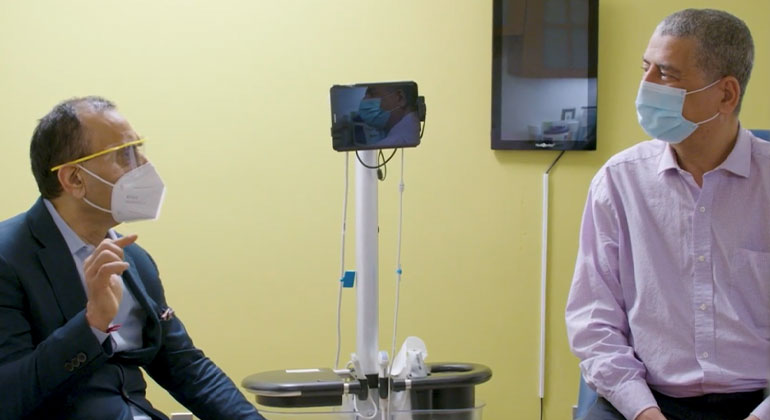Active Surveillance

If you have low-risk prostate cancer and want to avoid or delay the side effects of surgery or radiation, active surveillance might be a good option. This means we do not treat your cancer, so much as manage it. We keep a very close eye on any changes in your condition. At Mount Sinai, we recommend this treatment approach for some men whose cancer hasn’t spread outside the prostate (localized).
Most small prostate cancers are treated with surgery and/or radiation. Side effects of these treatments may continue after treatment. They may include:
- Decreased bladder control for up to one year
- Erectile dysfunction (ED) for one to two years
What is “low-risk” prostate cancer?
Doctors call prostate cancer low-risk if it fits the following:
- Gleason score of 6 or less, prostate-specific antigen (PSA) less than 10 mg/ml
- Tumor that cannot be felt or can be felt in less than half of one lobe of the prostate
- Classified as clinical stage T1c or T2a)
Research suggests that low-risk prostate cancer is unlikely to hurt you or shorten your life. One study found that among men on active surveillance for prostate cancer, only 1 percent developed metastatic cancer over 15 years. Of the most common cancers, prostate cancer is the only one where a slow-growing tumor does not require aggressive and immediate treatment.
Active surveillance is careful monitoring of your prostate. We closely observe and test so we can quickly detect the slightest change in your condition. It is not the same as watchful waiting, where doctors simply track symptoms. With watchful waiting, doctors do not start treatment unless you have symptoms. This means fewer doctor appointments and less testing than with active surveillance. If you experience any symptoms, such as issues with urinating, we can help.
Good Candidates for Active Surveillance
Active surveillance is most appropriate for you medically if:
- You aren’t experiencing any symptoms
- You have a slow-growing cancer (Gleason score of less than 6)
- Your cancer is small (cannot be seen on a digital rectal exam or ultrasound)
- The cancer is only in the prostate (localized)
- You have a low PSA level (less than 10 mg/ml)
- You are in treatment for another serious health condition—such as diabetes—whose effectiveness could be hurt by cancer treatment
- Genetic tests such as Decipher®, ProMark®, and Prolaris® show no concerning indications
- You are young enough that if the cancer develops, you would benefit from localized treatment
You may also want to discuss these issues with your doctor:
- Will not being in “active treatment” create worry and affect your quality of life?
- Does your age affect your response? Young men will live with cancer for longer than older men, so they have an increased risk of their cancer worsening over their lifetime. At the same time, younger men are more likely to be troubled by the treatment side effects, such as ED.
Testing Schedule
At Mount Sinai, we have a set protocol for actively surveilling low-risk prostate cancer. If you are in active surveillance, you will be checked and tested regularly. Testing will include:
Annually
- Micro-ultrasound
- 3 Tesla magnetic resonance imaging scans, with or without contrast
Every three to four months
- PSA testing
- Digital rectal exam
- Physical exam
Every three years
- Prostate biopsy (earlier if scans indicate progression)
- Genomic test performed on the biopsy sample (Decipher, Oncotype Dx)
If we find anything concerning, we may do additional testing to see if you need more active treatment. At Mount Sinai, we are here for you.

